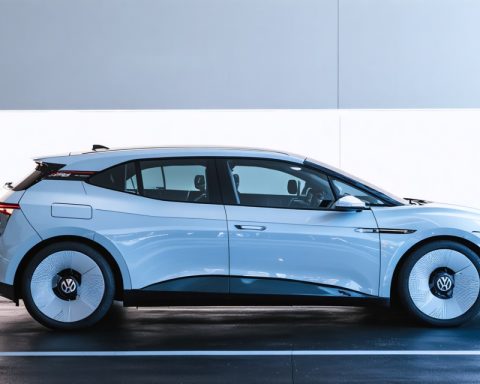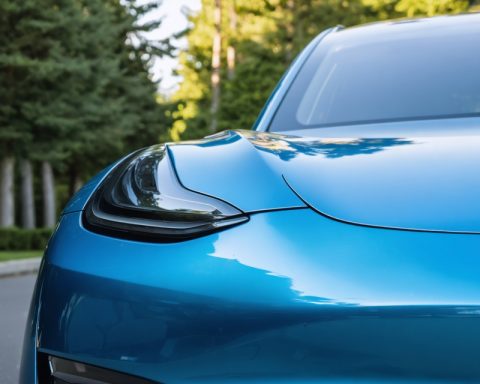- Fast-charging stations have revolutionized the EV experience, reducing charging times to 15-30 minutes.
- Utilizing advanced DC technology, these stations can deliver energy at up to 350 kW, comparable to traditional refueling experiences.
- Fast-charging hubs are integrated with renewable energy solutions to alleviate grid strain and enhance sustainability.
- These stations not only provide convenience but also help normalize EV usage by significantly reducing range anxiety.
- The ongoing advancement in battery and charging technology is expected to improve efficiency and further integrate EVs into mainstream mobility.
- Fast-charging stations are pivotal to the energy transition, highlighting the shift to a cleaner, more sustainable future.
In a world racing toward sustainability, electric vehicles (EVs) have emerged as powerful symbols of change. Fast-charging stations are pivotal in this narrative, transforming the EV experience from sluggish to sensationally swift.
History in the Making
Barely a decade ago, charging an EV required patience. Drivers had to endure lengthy waits while their vehicles juiced up, enough time to finish a novel or reconsider life choices. But as the demand for environmental responsibility surged, so did technological innovation. The advent of fast-charging stations has whittled away charging times to less than the time it takes to enjoy a cup of coffee—often just 15 to 30 minutes for a significant battery boost.
A Technical Triumph
Fast-charging stations, leveraging advanced DC (direct current) technology, have amped up the energy delivery game to a staggering 350 kW, rivaling traditional refueling stops. Unlike their AC (alternating current) counterparts, which functioned more like trickling streams, these stations unleash a veritable torrent of electrons. Picture a racecar swapping its tires in a blink rather than a leisurely pit stop; that’s the transformation fast-charging stations deliver.
The Urban Cool Factor
Imagine zipping into a chic, solar-paneled pavilion, nestled conveniently at highway interchanges or urban centers. Surrounded by dynamic digital displays and lush green landscaping, the experience feels less like a necessity and more like a stop in the future. Companies like Tesla, ChargePoint, and Electrify America have drawn the blueprint for these techno-havens, where drivers can recharge both their vehicles and their spirits.
<Bummer? Not quite. Concerns about potential grid strain have prompted a parallel evolution in renewable energy integration and smart grid technology. Fast-charging stations are increasingly coupling with energy storage systems or solar arrays, reducing dependency on conventional power sources and mitigating load spikes.
A Collective Leap Forward
For the average commuter, fast-charger proliferation represents more than just convenience—it’s a leap toward normalizing EVs in a fossil-fuel-dominated landscape. These stations are deconstructing range anxiety, reshaping the way society views road travel. A network of fast-charging routes sprawling across continents ensures that whether you’re navigating urban jungles or rural retreats, a recharge is a mere pitstop away.
What Lies Ahead
The future shines with the promise of breakthrough engineering and efficiency increases. As battery technology continues to evolve, fast-charging stations may soon become even faster, propelling EVs from niche players to mainstream mobility titans.
The Takeaway
Fast-charging stations symbolize not just a technological marvel but are a testament to human ingenuity. They enhance EVs’ allure and accessibility, dissolving the barriers to transition from gasoline to green. Next time you plug in, whether it’s for five minutes or fifty, you’re not just recharging a car—you’re partaking in the energetic shift toward a cleaner planet.
Fast-Charging EV Stations: The Future of Green Mobility
Exploring the Fast-Charging Revolution
Fast-charging stations for electric vehicles are not just a technical marvel but a pivotal player in the pursuit of sustainability. These stations have transformed the EV landscape, making daily commutes and long-distance travel more feasible. Let’s delve deeper into the latest advancements, industry trends, and actionable insights about this revolutionary technology.
Life Hacks: Maximizing Fast-Charging Efficiency
1. Pre-Condition Your Battery: Many newer EV models come with a ‘pre-conditioning’ feature to warm up the battery before reaching a fast-charger, increasing charging efficiency.
2. Charge at Optimum Levels: For long-term battery health, avoid charging beyond 80-90% unless necessary. This not only conserves battery lifespan but also frees up the charger for others more quickly.
3. Location Planning: Use apps like PlugShare or specific automaker apps to locate nearby fast-charging stations and check real-time availability.
Real-World Use Cases & Industry Trends
– Urban Commuters: Businesses and municipalities are integrating charging stations as part of public infrastructure, reducing logistical hassles for urban EV owners.
– Long-Distance Travel: Charging networks like Tesla Supercharger and Ionity enable seamless cross-country travel with strategically located stations along major highway routes.
Market Forecasts
– The fast-charging market is expected to grow from $3 billion in 2021 to over $27 billion by 2030, according to industry reports. This projection highlights not just increasing EV adoption but also rising consumer expectations for quick, accessible charging options.
Comparisons and Compatibility
1. Charging Speeds: Currently, charging speeds of up to 350 kW are available, significantly shortening downtime. By comparison, AC charging more commonly delivers 7-22 kW.
2. Compatibility: Most fast-charging stations are compatible with the CCS or CHAdeMO standards, covering a wide range of electric vehicles.
Controversies and Limitations
– Grid Impact: Rapid charging can place substantial demands on electrical grids. Policymakers and utility companies are exploring solutions such as integrating renewable energy sources and energy storage systems.
– Batteries Wear Faster: Frequent use of fast-charging can degrade battery health faster over time compared to slower charging methods.
Actionable Recommendations
– Educate Yourself: Familiarize yourself with your car’s charging ports and fast-charging capabilities before heading out on a long journey.
– Join Networks: Enroll in membership programs offered by major networks like ChargePoint for potentially reduced pricing and additional benefits.
– Consider Solar: As fast chargers integrate with solar technology, consider EV models and chargers supporting this evolution to make your travel more sustainable.
Conclusion: A Dynamic Transition
Fast-charging stations are a crucial enabler in the broader adoption of electric vehicles. They reduce range anxiety, facilitate rapid travel, and symbolize the shift toward a sustainable future. By embracing this innovative approach to transportation, you’re not only optimizing your drive but also contributing to a cleaner planet.
For more insights on electric vehicle technology and sustainability strategies, visit the official Tesla website where you can explore the latest in EV innovation and charging solutions.













